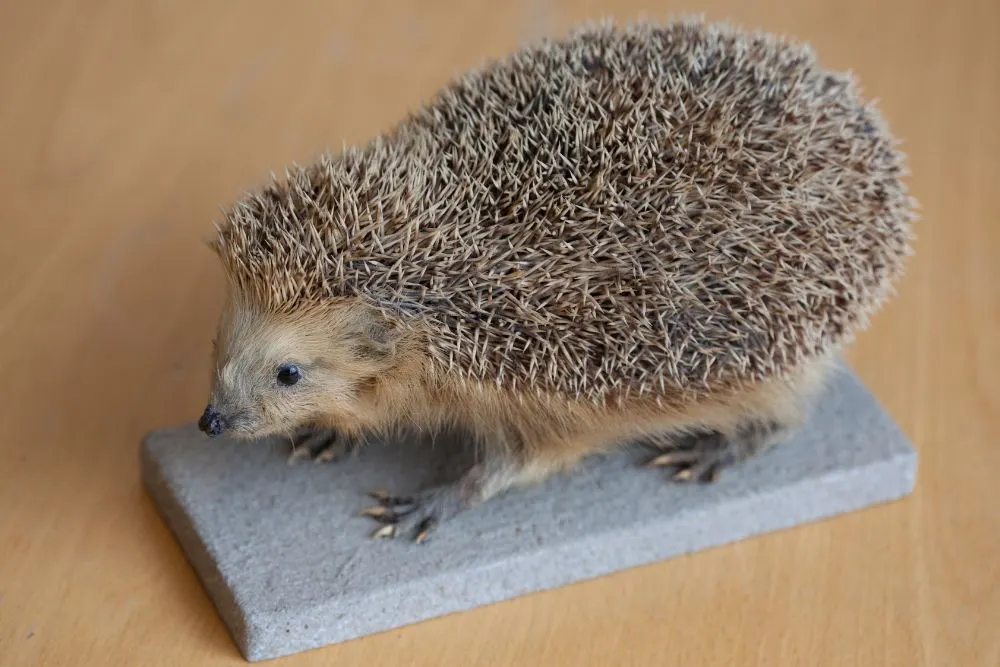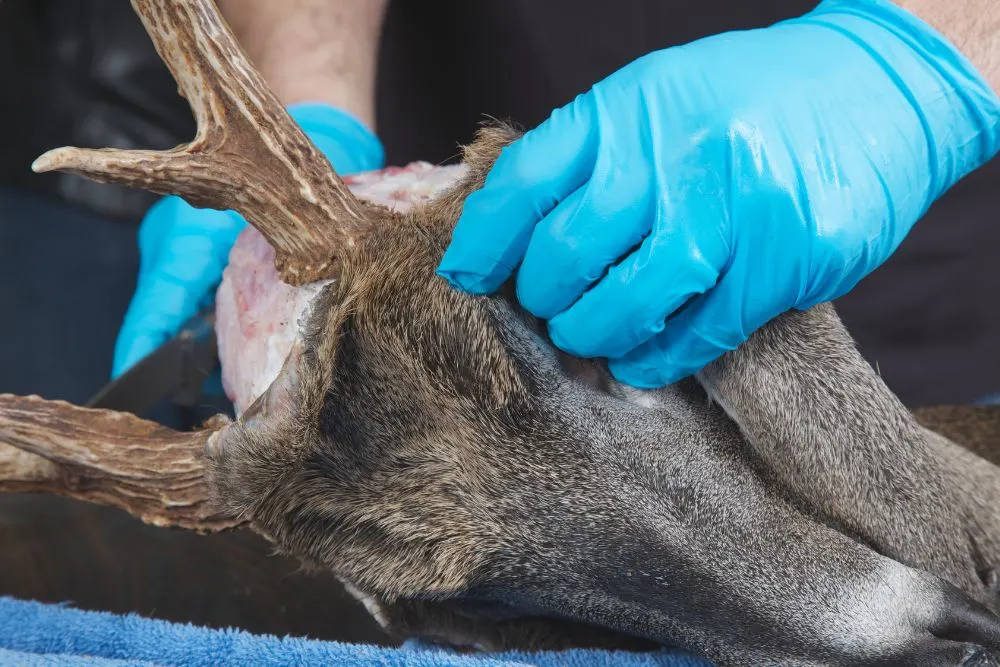Taxidermy is a unique art that combines craftsmanship, animal anatomy, and an eye for detail. It involves the preservation and mounting of animal skins to create lifelike displays, which require a high level of skill and practice.

While the thought of becoming a taxidermist might seem daunting, the process involves a few key steps to help you achieve your goal.
One of the first things to consider when pursuing a career in taxidermy is the education and training required. While a college degree is not necessary, it’s important to gain hands-on experience and attend a taxidermy program offered by accredited trade schools or community colleges. These programs typically cover the technical and artistic aspects of the profession, giving students the chance to collaborate with experienced professionals.
Another important aspect of becoming a taxidermist is obtaining proper certification. Special certification programs, which can take anywhere from a couple of weeks to a year to complete, are essential in showcasing your expertise and skill set. Additionally, consider attending workshops that offer short, focused courses on specific areas of taxidermy to further enhance your craft.

Essential Skills for a Taxidermist
Becoming a skilled taxidermist involves mastering a variety of essential techniques and artistry. In this section, we will discuss some of the most important aspects every aspiring taxidermist should focus on, such as anatomy knowledge, sculpting and painting, as well as sewing and finishing skills.
Anatomy Knowledge
A critical component of taxidermy is understanding animal anatomy. This knowledge enables taxidermists to recreate accurate and lifelike animal figures, significantly improving the quality of their work. Not only should taxidermists be familiar with the skeletal systems of various species, but they should also understand the musculature, tissue placement, and skin composition.
Here are a few ways to gain anatomy knowledge:
- Study books and articles on animal anatomy
- Dissect specimens under the guidance of an experienced taxidermist
- Observe live animals for movement and posture details
Sculpting and Painting
Sculpting and painting are integral to creating realistic animal representations. Taxidermists must be skilled in molding forms, carving intricate details, and accurately painting various textures and patterns.
To improve your sculpting and painting skills, consider:
- Attending art classes focused on these techniques
- Practicing with a variety of materials, such as clay or foam
- Learning from other taxidermists and observing their techniques
Sewing and Finishing Skills
Once the form has been sculpted, taxidermists use their sewing skills to attach the preserved skin to the form. This process requires careful attention to detail and precision to create seamless and durable connections.
In addition to sewing, taxidermists must also have expertise in finishing techniques, such as:
- Properly tanning and preserving animal skins
- Seamlessly blending the skin with the sculpted form
- Repairing and restoring any damage to the specimen
To hone your sewing and finishing skills, practice on sample materials and seek guidance from experienced professionals in the field. As you gain experience, your skills will improve, enabling you to create realistic and visually stunning taxidermy projects.

Education and Certification
Becoming a taxidermist doesn’t require a college degree, but having some formal education and certification can help you stand out in the industry. In this section, we will discuss taxidermy courses and schools, as well as certification programs.
Taxidermy Courses and Schools
Taking up taxidermy programs can provide you with the necessary training and experience. Some community colleges and trade schools offer intensive two-year programs in taxidermy. These programs combine artistic and technical aspects of taxidermy, allowing students to work hands-on and gain practical knowledge.
You can also opt for some certificate and diploma programs available through trade schools. These programs are usually shorter in duration and may range from a few weeks to a couple of months.
Certification Programs
Although not mandatory, securing a certification as a taxidermist can help to showcase your skill and expertise to potential clients. Certification programs typically focus on subjects like animal biology, anatomy, and appropriate techniques for handling and preserving various species.
Additionally, some taxidermists may need to obtain a federal permit, depending on the specific laws and regulations in their region. Make sure to research and comply with any legal requirements you may encounter in your area.
To sum up, while a college degree is not necessary, investing time and effort in completing taxidermy programs and certifications can significantly boost your credibility and open doors to various opportunities in the field.

Career Path and Job Outlook
Work Environment and Opportunities
Taxidermists can work in various environments, including museums, wildlife centers, hunting lodges, or privately owned taxidermy businesses. Some taxidermists may choose to be self-employed and run their businesses from their homes or studios. The demand for well-qualified taxidermists continues to grow, thanks to the popularity of hunting and fishing trophies. In fact, it is not unusual for skilled taxidermists to have a year’s worth of work backlogged.
Income and Career Progression
The income of a taxidermist can vary widely depending on factors like location, experience, and the type of work performed. However, with experience and a loyal client base, taxidermists can see a steady increase in their income. As they hone their skills and gain a reputation for quality work, they can charge higher fees for their services. Taxidermists can also diversify their skill set by specializing in specific animals or taxidermy techniques.
Tasks and Duties
A taxidermist’s main tasks include:
- Measuring animals to create accurately sized mounts.
- Removing the animal’s hide and tanning the pelt.
- Sculpting, painting, and sewing to create lifelike displays.
An essential aspect of the taxidermy process is attention to detail, ensuring that the finished product looks as close to the living animal as possible. In addition to their artistic skills, taxidermists must have a strong knowledge of animal biology to create realistic mounts. To become a taxidermist, individuals can choose to develop their skills through hands-on experience or by completing a certification program. Additionally, aspiring taxidermists in the US must obtain a license and/or federal permit, although regulations vary by state.
Aspiring taxidermists should consider developing their art skills, especially in sculpting, painting, and sewing, which are the most used techniques in taxidermy. With dedication and practice, those interested in this profession can build a rewarding and potentially lucrative career capturing the beauty of the natural world in lifelike displays.
Taxidermy Techniques and Preservation
Taxidermy is the art of preserving animals’ bodies by mounting them using various techniques. It requires a deep understanding of animal anatomy, sculpting, and painting. In this section, you’ll learn the basics of taxidermy techniques and preservation, focusing on small and big game, as well as fish and bird taxidermy.
Small and Big Game Taxidermy
Small game taxidermy involves preserving smaller animals such as squirrels, rabbits, and raccoons. Big game taxidermy, on the other hand, focuses on larger animals like deer, bears, and elk. The process for both small and big game taxidermy typically involves:
- Skinning the animal and removing the flesh carefully
- Tanning the skin
- Creating a custom form that replicates the animal’s body size and shape
- Mounting the tanned skin on the form
- Adding realistic eyes and teeth
- Airbrushing and painting to replicate the animal’s natural coloring.
Fish and Bird Taxidermy
The preservation of fish and birds requires a slightly different approach because these animals have delicate skin and unique features. Here are some essential steps for fish and bird taxidermy:
- Careful skinning to minimize damage to delicate skin or feathers
- Cleaning and preserving the skin with chemical treatments
- Creating a customized form to match the animal’s body shape
- Attaching the skin to the form while maintaining the natural feather or scale pattern
- Adding eyes, beak or mouth details, and painting as needed for realism
To summarize, taxidermy is a complex art that involves knowledge of animal anatomy, sculpting, and painting skills. The techniques and preservation process for small and big game, as well as fish and bird taxidermy, differ. However, they all involve skinning, tanning, and mounting the animal’s preserved body on a custom form for display.
Materials and Tools
Becoming a taxidermist demands working with various materials and tools. In this section, we will discuss some essential materials and tools you’ll need.
Pre-made Forms and Lightweight Materials
Pre-made forms are commonly used by taxidermists. They are made from foam or other lightweight materials like wood. You can either purchase these or create your own. Another option to create your custom forms is by sculpting clay over wire framing. Plaster casts are also used to get accurate molds of the skinless carcass.
Glass or Acrylic Eyes, Teeth, and Claws
Realistic eyes, teeth, and claws are vital for a lifelike appearance. Taxidermists usually opt for glass or acrylic eyes for their projects. These can be obtained in various sizes and colors to match the animal accurately.
Knives, Scalpels, and Scissors
Some essential tools for taxidermy work include knives, scalpels, and scissors. They are vital for making precise incisions, maneuvering around a deceased animal carcass, and cutting materials like synthetic materials and foam.
When working on a specimen, taxidermists often use:
- Knives: for skinning and trimming the disassembled parts
- Scalpels: for delicately removing fat and making fine cuts
- Scissors: for precise cutting of fabrics and synthetic materials
In addition to the tools mentioned above, here are other materials and tools you may need:
- Salt: for preserving the skin and removing excess moisture
- Special chemicals: to help disinfect and preserve the carcass
- Rigid sculpture: a base to create realistic poses for your specimens
- Staples, glue, and thread: for attaching and securing the parts together
- Wire framing and clay: for adding structure and support to your creations
By using these materials and tools skillfully, you can develop your taxidermy skills and create stunning, lifelike pieces.
Legal Aspects and Industry Opportunities
Taxidermy Laws and Regulations
Taxidermy laws and regulations vary by state in the US. Aspiring taxidermists are usually required to obtain a license and/or federal permit to legally practice their profession. It is essential to have a good understanding of animal biology and secure certification as a taxidermist to ensure compliance with these regulations. Visit your state’s wildlife agency or fish and game department for specific information on licensing requirements.
Conventions and Events
Conventions and events related to taxidermy provide excellent networking and learning opportunities for taxidermists. These gatherings often showcase new techniques, materials, and trends in the industry. Additionally, they may offer workshops, seminars, and competitions focusing on:
- Art and sculpting for taxidermists
- Innovative mounting and display methods
- Lifelike exhibits and dioramas
Participating in these events can be highly beneficial for professional development and staying current within the field.
Career Opportunities in Various Industries
There is a wide range of industries seeking skilled taxidermists. Some of the primary sectors that provide career opportunities include:
- Hunting trophy displays: Many hunters and sportsmen desire taxidermy services for preserving and displaying their trophies.
- Museums and scientific displays: Taxidermists play a vital role in preserving specimens for museum exhibits and educational purposes. Professionals with backgrounds in art education or museum studies have an added advantage in this area.
- Theme parks and entertainment venues: Lifelike taxidermy displays and dioramas contribute to realistic and engaging experiences in theme parks and other entertainment settings.
- Office and commercial displays: Businesses often seek taxidermists for creating high-quality replicas or preserved specimens to enhance their interior spaces.
As a taxidermist, developing your skill set and staying informed of trends and innovations will allow you to explore these diverse opportunities within the industry.
